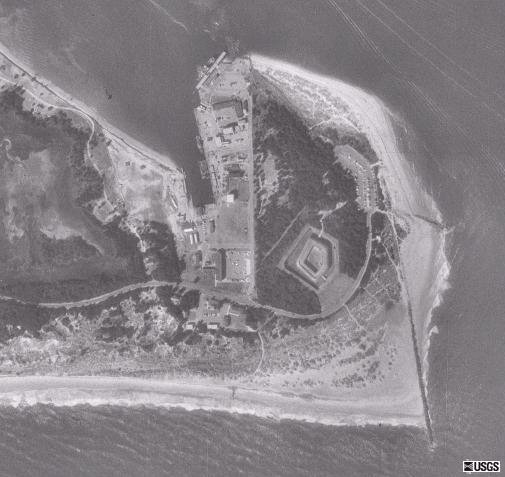A Brief History of Fort Macon
and Cape Lookout Military Reservation
(1834 - 1903, 1941 - 1945)
Earlier forts were located here, including: Fort Dobbs (1756), which was never
completed, and Fort Hampton (1809). The sites of both eventually eroded into the
sea. The inlet was undefended during the American Revolution. The current fort was one
of only three masonry forts in the state before the Civil
War. The Confederates held it from 1861 to April 1862. The fort was used as a federal prison
from 1865 to 1876. A temporary battery was set up on the parapet in 1898 for the
Spanish-American War. This was the second state park established in North Carolina (1924).
It was restored in 1935. The Army regained
the use of the fort in WWII, and was required to demolish every newly built structure prior
to handing it back to the state after the war.
At Cape Lookout was once Fort Hancock (1778 - 1780). It was built by the French to
protect their ships in Lookout Bight. It was later dismantled. An earlier colonial fort may
have also been here in 1757. A colonial fort was located at Bear Inlet in 1749 to protect
against the Spanish. During the Civil War the Confederates built a 6-gun earthwork battery
at Huggins Island. It was captured by the Union in April 1862.
TEMPORARY HARBOR DEFENSES of BEAUFORT INLET
These defenses were under the command of the Chesapeake Bay Sector, based at Fort Monroe,
Hampton, Virginia.
On the beach at Ft. Macon during World War II was Battery Macon, which had four
155mm guns (1941-1942) in revetments and two 6-inch naval guns (1942-1944) on concrete
mounts. It is now buried in the surf. Two 75mm field guns were emplaced on Bogue Point
in 1941. Two mobile 90mm guns were emplaced on Bogue Point (1944-1945) near the rock
jetty as an examination battery. Battery Atlantic Beach (1941-1942), four 155mm
guns in revetments, was located two and a half miles west in Atlantic Beach, almost
due south of Camp Glenn in Morehead City. Two guns were later sent to Cape Lookout. There
was a concrete CRF observation post and plotting room (now in ruins) behind Battery Macon,
another observation post by Battery Atlantic Beach, and a Harbor Entrance Control Post
(dismantled after the war) on the parapet of Fort Macon. Another observation post was
located on Shackleford Banks, on the western side by the inlet, and another about two
miles west of Battery Atlantic Beach on Bogue Banks. There were seven searchlight
positions from Atlantic Beach to Cape Lookout Point.
At Cape Lookout was Battery Cape Lookout which had two 155mm guns (1942) in
revetments, and later two 5-inch naval guns (1942-1944) on concrete mounts. That battery
is now in the surf near the old Coast Guard Station. An SCR-296A radar tower was in the
dunes in front of the Coast Guard Station, and a wooden Battery Commander's tower was on
the shore behind the battery (concrete foundation still exists). Observation posts were
located on Shackleford Banks near Bald Hill Bay, and on South Core Banks about four miles
northeast of the Lighthouse. A Naval Radio Compass tower was 340 yards west of the
SCR-296A radar tower. There were four 75mm guns (1941-1943) in field emplacements around
the Coast Guard Station. Lookout Bight was a mined and net-protected safe anchorage for
allied merchant ships until 1944.
{see "American Seacoast Defenses" 2nd Ed. page 190 for 155mm, page 194 for 5-inch and
6-inch,
and page 250 for mobile 90mm mentioned in the text above.}



Satellite Images of Fort Macon and Cape Lookout
courtesy of Microsoft TerraServer

Proceed to Photo Gallery

* Official Link
to Fort Macon State Park *
* Friends of Fort Macon State Park *
* Official Link to Cape Lookout
National Seashore *
